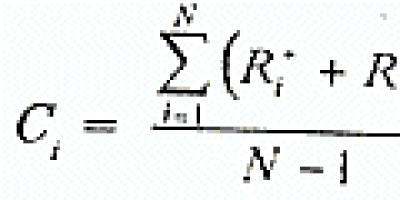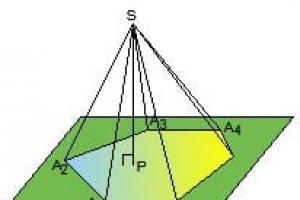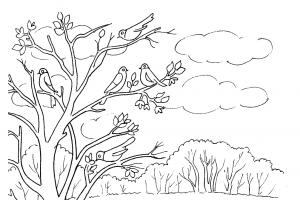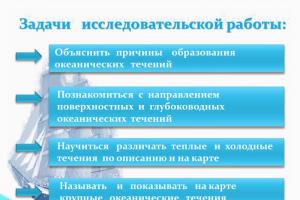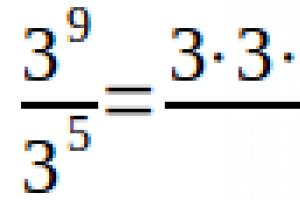Lesson objectives:
- To develop students' knowledge about the types of evolutionary changes.
- Consider, using specific examples, the paths of evolution of the organic world and the relationship between them.
- To introduce the main directions of evolution of the organic world - biological progress and biological regression.
- Show the role of Russian scientists in the development of evolutionary teaching.
- To develop skills in identifying aromorphoses and idioadaptations in flora and fauna.
Equipment: textbook on biology “Homologous and similar organs of plants and animals”, presentation for the lesson.
DURING THE CLASSES
I. Updating of reference knowledge
– What is biological evolution? (B. evolution is the irreversible development of the organic world).
– What evolutionary process is called microevolution? (The process of formation of new species).
– What is macroevolution? (The process of formation of larger systematic units - genera, families, etc.).
II. New material
1. Types of evolutionary changes (lecture, conversation).
(As students view the slides, they write down definitions in their notebooks.)
The main types of evolutionary changes include parallelism, convergence and divergence ( Annex 1 , slide 2).
Parallelism is the independent acquisition of similar characteristics by related organisms living in the same conditions and leading a similar lifestyle.
For example, the body structure of mammals inhabiting the rainforests of Africa and South America is generally similar ( Annex 1
, slide 3).
Convergence
– the emergence of similar structural features in unrelated organisms living in the same conditions and leading a similar lifestyle.
For example, large aquatic predators gave rise to four groups of animals: mollusks, reptiles, birds, and mammals.
What common structural features can be identified in these animals belonging to different systematic groups ( Annex 1
, slide 4)? (Fins, streamlined body shape).
Convergent evolution affects only the external structure of organisms, which is associated with environmental conditions. The wing of a bird and a butterfly are an adaptation for flight, but the origin and structure of these organs are different. Organs that are different in origin, but perform similar functions are called analogous ( Annex 1
, slide 5)
Divergence - divergence of characteristics within a population or species, arising under the influence of natural selection, leading to the emergence of new species, orders, classes, etc.
As a result of divergent evolution, the class of mammals split into numerous orders, the representatives of which differ in structure, lifestyle, and the nature of physiological and behavioral adaptations ( Annex 1
, slide 6).
– What caused the formation of numerous groups of mammals? (Adaptation to different environmental conditions)
The modified limbs of a whale, bird, bat, mole, rat are the result of divergent evolution. These organs have the same general structure, but perform different functions. Such organs are called homologous ( Annex 1
, slide 7).
2. Paths and directions of evolution of the organic world
Major Russian scientists A.N. made a significant contribution to the development of the problem of evolution. Severtsev and I.I. Schmalhausen. They found that the main paths of evolution are aromorphosis, idioadaptation, degeneration ( Annex 1 , slide 8).
The contribution of Russian scientists to the development of evolutionary teaching(short messages from students)
A.N. Severtsev is a famous zoologist and a major theorist of evolutionary theory. Founder of the national school of evolutionary morphologists. Organized and headed the Laboratory of Evolutionary Morphology and Animal Ecology. Creator of the generally accepted theory of the origin of the five-fingered limb and paired fins in animals. The author of the theory of phylembryogenesis, according to which new characters can appear at any stage of ontogenesis, and the morphobiological theory of evolutionary paths, in which he established four main directions of biological progress: aromorphosis, idioadaptation, cenogenesis, general degeneration.
I.I. Shmalgauzen graduated from Kiev University in 1907. Student of A.N. Severtsev. At Moscow University he headed the department of Darwinism that he organized. For twelve years he headed the Institute of Evolutionary Morphology of the USSR Academy of Sciences. His numerous works are devoted to comparative anatomy and embryology, evolutionary morphology, the origin of terrestrial vertebrates, paths and patterns of evolution, and biocybernetics. His studies of the mechanisms of the evolutionary process and individual development as auto-regulatory systems anticipated a number of provisions of cybernetics, from the standpoint of which he in the 1950-60s. expounded the theory of evolution. His scientific legacy has had and continues to have a great influence on the development of biological science.
(BENP, “Kirill and Melody”, 2003)
Aromorphosis
– adaptive changes of general significance that increase the level of organization and viability of individuals, populations, and species.
The first terrestrial vertebrates gave rise to a group of lobe-finned fish, thanks to changes in the structure of the skeleton of paired fins. As a result, five-fingered limbs were formed capable of supporting the body above the ground ( Annex 1
, slide 9).
An example of aromorphosis in plants is the appearance of a flower (modified shoot) in angiosperms.
Idioadaptation is a particular adaptive change that is useful in a given environment and occurs without changing the general level of organization.
An example of idioadaptation in animals is the diversity of beaks of Hawaiian flowerbirds that feed on the nectar of various angiosperms.
Adaptation to seed dispersal by wind is an example of one of the ideological adaptations in plants ( Annex 1
, slide 10)
Correlation of evolutionary paths
The muskrat is a North American introduced species whose distribution area is constantly expanding. As a result, it begins to displace native species with similar ecological needs, such as the muskrat and water vole.
Biological regression ( Annex 1
, slide 14) is characterized by:
- Decrease in the number of individuals.
- Narrowing of the range.
- Reducing the number of species and populations.
The cause of biological regression may be a change in environmental conditions to which the species was unable to adapt or competition from other species. This was the case with the numerous dominant group of reptiles on Earth, which, thanks to their warm-bloodedness, were replaced by birds and mammals.
At present, by changing the environment, thoughtlessly moving species to new conditions of existence, man, willy-nilly, becomes the cause of biological progress or regression. Annex 1
, slide 21)
V. Homework:§63, notebook.
Was used:
1. Educational electronic publication “Ecology”, Moscow State Institute of Electronics and Mathematics, 2004.
2. 1C: School, Ecology, 10-11 grades, edited by A.K. Aklebinina, V.I. Sivoglazova
3. Laboratory practice. Biology 6-11 grades. Republican Multimedia Center, 2004.
4. BENP, biology 6-11 grades, Ministry of Education of the Russian Federation, GURC EMTO “Kirill and Mifodiy”, 2003.
5. D.K. Belyaev, A.O. Ruvinsky, General biology for grades 10-11, Moscow, “Enlightenment”, 1991.
6. A.A. Kamensky, E.A. Kriksunov, V.V. Beekeeper, General biology, 10-11 classes. DROFA, Moscow, 2005.
7. Lessons in general biology: A manual for teachers / V.M. Korsunskaya, G.N. Mironenko, Z.A. Mokeeva, N.M. Verzilin - M: Education, 1986.
Macroevolution is a generalized picture of evolutionary transformations. Only at the level of macroevolution are general trends, directions and patterns of evolution of the organic world revealed.
During the second half of the 19th – first half of the 20th centuries, based on numerous studies of the laws of the evolutionary process, the main rules(principles)evolution. (These rules are limited in nature, do not have universal meaning for all groups of organisms, and cannot be considered laws.)
1. Rule of irreversibility of evolution, or Dollot's principle (Louis Dollot, Belgian paleontologist, 1893): a disappeared feature cannot reappear in its previous form. For example, secondary aquatic mollusks and aquatic mammals have not restored gill respiration.
2. Rule of descent from unspecialized ancestors, or Cope's principle (Eduard Cope, American paleontologist-zoologist, 1904): a new group of organisms arises from unspecialized ancestral forms. For example, unspecialized insectivores (such as modern tenrecs) gave rise to all modern placental mammals.
3. Rule of Progressive Specialization, or the Depere principle (C. Depere, paleontologist, 1876): a group that has embarked on the path of specialization will, in its further development, follow the path of ever deeper specialization. Modern specialized mammals (Chiroptera, Pinnipeds, Cetaceans) will most likely evolve along the path of further specialization.
4. Adaptive Radiation Rule, or the Kovalevsky-Osborne principle (V.O. Kovalevsky, Henry Osborne, American paleontologist): a group in which an unconditionally progressive trait or a set of such traits appears gives rise to many new groups that form many new ecological niches and even enter other habitats. For example, primitive placental mammals gave rise to all modern evolutionary-ecological groups of mammals.
5. Rule for the integration of biological systems, or Schmalhausen’s principle (I.I. Shmalhausen): new, evolutionarily young groups of organisms absorb all the evolutionary achievements of ancestral groups. For example, mammals used all the evolutionary achievements of ancestral forms: the musculoskeletal system, jaws, paired limbs, the main parts of the central nervous system, embryonic membranes, perfect excretory organs (pelvic kidneys), various derivatives of the epidermis, etc.
6. Phase change rule, or the Severtsov-Schmalhausen principle (A.N. Severtsov, I.I. Shmalhausen): various mechanisms of evolution naturally replace each other. For example, allomorphoses sooner or later become aromorphoses, and on the basis of aromorphoses new allomorphoses arise.
In addition to the rule for changing phases, J. Simpson introduced a rule for alternating rates of evolution; Based on the speed of evolutionary transformations, he distinguished three types of evolution: bradytellic (slow pace), horotellic (medium pace) and tachytellic (fast pace).
End of form
Topic 10: Main directions of evolution
1. Biological progress. Unlimited progress. Biological stabilization and biological regression
2. Arogenesis and aromorphoses. Epimorphosis
3. Allogenesis and its forms
4. Catagenesis and its forms
5. Phase change rule
Patterns evolutionary process Rules of evolution

Let's repeat the basic concepts...
Find a match:
Term
Latin name
- Aromorphosis
A. “Adjustment”, “adjustment”
- Degeneration
B. Simplification of the general organization of the body
B. “Degenerate”
- Idiomatic adaptation
D. Improving the forms of the body, contributing to an increase in overall organization, providing advantages in different environments
D. “I lift” + “shape”
E. Adaptations to special conditions, but not changing the level of organization
Answers: 1-D-G; 2-V-B; 3-A-E

Which of the following applies to aromorphosis, idioadaptation, degeneration?
1. Cellular lungs in reptiles
2. Primary cerebral cortex in reptiles
3. Beaver has a bare tail
4. Snakes lack limbs
5. Lack of roots in dodder
6. the appearance of a septum in the stomach of the heart in reptiles
7. Mammary glands in mammals
8. Formation of flippers in walruses
9. Lack of a circulatory system in tapeworms
10. Lack of sweat glands in dogs

Aromorphoses
Idiomatic adaptations
Degeneration
Grading criteria:
16 – 14 points – 5
13 – 11 points – 4
10 – 7 points – 3
6 – 0 points – 2

How do you understand these terms?
- Evolution -
- Progress -
- Regression -
- Pattern -
Deployment
Forward movement
Return, moving back
Law, rule

ARE THERE
ANY REGULARITIES OF THE EVOLUTIONARY PROCESS?

MACROEVOLUTION
Specialization of organs
Evolutionary directions
Biological
Process
Biological
Regression
Biological
stabilization
Formation of new genera and families
Units, classes and types.
Directions
Degeneration
Idiomatic adaptation
Aromorphosis


Patterns of the evolutionary process
Divergence
Convergence
parallelism
Assignment: find answers in the text of the textbook (from 66-69)
- What's happened …?
- What is the mechanism...?
- Results …?

Divergence
What's happened …?
Divergence is the process of divergence of characters in genetically similar organisms as a result of their adaptability to different living conditions
Galapagos finches

Divergence
What is the mechanism...?
The mutation process, isolation, struggle for existence, natural selection preserve characteristics that are more and more noticeably different from the parents
Divergence of ungulates

Divergence
results …?
Formation of new species
Homologous organs - similar in structure, having a common origin, but performing different functions

Examples homologous organs
Modified leaves:
pea tendrils
spines cactus
spines barberry

Convergence
What's happened …?
Convergence is the emergence of similar adaptations to the same conditions of existence in distant groups of organisms on the basis of organs of different origins
African rain forest mammals
Mammals of the rain forests of South America

Convergence
What is the mechanism...?
Selection of similar characters in the same habitat into which unrelated organisms find themselves
Shark
Ichthyosaur
Dolphin

Convergence
results …?
Chameleon and agama
External similarity of organisms
Analogous organs - perform similar functions, but have a fundamentally different structure and origin

Wings:
butterflies
birds


Macroevolution
Specialization of organs
Evolutionary directions
convergence
Divergence
Biological
Process
Biological
Regression
Similar
organs
Homologous
organs
Formation of new genera and families
Units, classes and types .
Directions
Degeneration
Idiomatic adaptation
Aromorphosis

Parallelism
parallelism- a process when an organ, as a result of divergence, turns into many homologous organs. But then, in the course of evolution, these homologous organs again begin to perform a common function.
the bodies of an ichthyosaur, a shark and a dolphin (and even a penguin swimming in the water) are very similar and were formed from the same skeletal elements, but along completely different evolutionary paths.

The process of historical development of a species is called phylogeny

Is evolution reversible?
If the previous conditions of existence are restored on Earth, will dinosaurs appear again?

Rules of evolution
The rule for alternating the main directions of evolution

Rule of irreversibility of evolution
Louis Dollo
(1857-1931)
Belgian
paleontologist
“An organism never returns exactly to its previous state, even if it finds itself in conditions of existence identical to those through which it passed. But due to the indestructibility of the past, he always retains some trace of the intermediate stages that he has passed through.”


What evidence can be given for the irreversibility of evolution?
reptiles do not give rise to amphibians again
land vertebrates - ichthyosaurs and whales, having returned to the water, did not turn into fish

Ernest Haeckel's Law
Ontogenesis is an accelerated repetition of phylogeny
organisms in the process of embryonic development repeat all the stages that the species went through in the process of evolutionary development


Let's sum it up...
- What is divergence?
- What is divergence?
2. Results of divergence?
- 2. Results of divergence?
3. What is convergence?
- 3. What is convergence?
4. Results of convergence?
- 4. Results of convergence?

Look at the pictures. Determine which of the organs are examples of homology and which are analogies? Indicate the numbers: A – similar bodies; G-homologous organs.
6
1 – barberry spines arise from leaves; 2 – white acacia from stipules; 3 – hawthorn – from shoots; 4 – blackberries – from bark; 5 – pea tendrils made from leaves; 6 – cactus spines from leaves


1. Compare organisms and determine the form of evolution
Mole.
The front legs are turned outward and have wide palms and powerful flat claws and are excellent tools for digging the ground.
Medvedka.
Large insect. The front pair of limbs are modified and are an excellent tool for digging the ground.

2. Compare organisms and determine the shape of evolution
Scots pine.
The needles are arranged 2 in a bunch, length 4-6 cm. The seeds are black, 4-5 mm, with a 12-20 mm membranous wing.
Cedar pine.
The needles are located 5 in a bunch, length 6-14 cm. The seeds are large, without wings.

3. Compare organisms and determine the shape of evolution
The brown hare lives in fields and steppes. By winter it gets a little lighter. Cannot move in deep bliss.
The white hare lives in the forest. By winter it changes color to pure white. Moves easily through deep snow.

4 . Compare organisms and determine the shape of evolution
Fat-tailed sheep.
Has fat deposits (fat tail) in the tail area.
Camel.
Has a reserve of fat contained in the humps.

5 . Compare organisms and determine the shape of evolution
Camel
Bactrian camel

6. Compare organisms and determine the shape of evolution
The front pair of limbs are claws. Leads a nocturnal lifestyle.
Scorpion.
Its appearance is quite terrifying: eight legs and menacing “tentacles” with claws. Leads a nocturnal lifestyle.

7. Compare organisms and determine the shape of evolution
Crayfish is a freshwater invertebrate animal of the arthropod type, covered with a shell and having claws and an abdomen similar to a tail.
The crab is a marine invertebrate animal of the order of decapod crustaceans; short-tailed crayfish.

8 . Compare organisms and determine the shape of evolution
Great pond snail
Inhabitant of reservoirs.
Grape snail
- one of the largest land snails in Russia.

9 . Compare organisms and determine the shape of evolution
Teen swimmer
painted black, and the body length is slightly more than a centimeter. Avoids open water, spending all the time in thickets of green algae and duckweed near the surface of the water. Its short legs are adapted for climbing in thickets of aquatic plants.
Fringed swimmer.
Its body length reaches 3-4 cm, prefers open water. Swims great the hind legs function as oars, are flat, with long bristles.

10 . Compare organisms and determine the shape of evolution
Kangaroo.
Jerboa.
Has long hind limbs of the jumping type

eleven . Compare organisms and determine the shape of evolution
Toad.
Prefers less humid places, dry, rough skin, short limbs. Falls into suspended animation.
Frog.
Prefers damper places, moist skin, long limbs. Falls into suspended animation.

12 . Compare organisms and determine the shape of evolution
Frog
Housefly

13 . Compare organisms and determine the shape of evolution
Hummingbird
Hawkmoth
does not sit on a flower while feeding, but hovers above it in the air, just as quickly moving its narrow wings

1 4. Compare organisms and determine the form of evolution
Echidna

Let's test ourselves!
Divergence
Convergence
1, 4,6,10,12,13,14
Grading criteria:
14-13 score 5
12-10 score 4
9-6 score 3
6-0 score 2

Conclusions:
Evolution is a continuous process of the emergence and development of new adaptations, continuous, irreversible

Homework:
Study §13,
terminology,
With. 66-70

Literature
Zakharov V.B. General biology: textbook. for 11th grade general education institutions / V. B. Zakharov, S. G. Mamontov, N. I. Sonin. – M.: Bustard, 2005.
When preparing the presentation, materials were used: http://images.yandex.ru/yandsearch?text
>> Basic patterns of evolution
Basic laws of evolution.
1. What is evolution?
2. What facts support the doctrine of evolution?
When constructing phylogenetic series, evolutionary biologists, in addition to paleontological data, widely use the comparative method, with which they establish similarities in the structure of organisms, their biochemical reactions, reproductive characteristics or other properties by which one can judge the paths of development of a group from a common ancestor.
Lesson content lesson notes and supporting frame lesson presentation acceleration methods and interactive technologies closed exercises (for teacher use only) assessment Practice tasks and exercises, self-test, workshops, laboratories, cases level of difficulty of tasks: normal, high, olympiad homework Illustrations illustrations: video clips, audio, photographs, graphs, tables, comics, multimedia abstracts, tips for the curious, cheat sheets, humor, parables, jokes, sayings, crosswords, quotes Add-ons external independent testing (ETT) textbooks basic and additional thematic holidays, slogans articles national features dictionary of terms other Only for teachersThe morphofunctional characteristics of living organisms are determined by two factors: physiological needs and specific environmental conditions. With all the diversity of particular structural features and adaptations of organisms to the external environment, some general patterns of the evolutionary process can be identified.
Patterns of the evolutionary process
Data from systematics, paleontology, comparative anatomy and other biological disciplines make it possible to reconstruct with great accuracy the course of the evolutionary process at the supraspecific level. Among the forms of evolution of groups of living organisms we can distinguish: divergence, convergence and parallelism.
Divergence. The emergence of new forms is always associated with adaptation to local geographical and environmental conditions of existence. Thus, the class of mammals consists of numerous orders, whose representatives differ in the type of food, characteristics of habitats, that is, living conditions (insectivores, chiropterans, predators, artiodactyls, cetaceans, etc.). Each of these orders includes suborders and families, which, in turn, are characterized not only by specific morphological characteristics, but also by ecological features (running, jumping, climbing, burrowing, swimming forms). Within any family, species and genera differ in lifestyle, food items, etc. As Darwin pointed out, divergence is the basis of the entire evolutionary process. Divergence of any scale is the result of the action of natural selection in the form of group selection (species, genera, families, etc. are preserved or eliminated). Group selection is also based on individual selection within a population. The extinction of a species occurs due to the death of individual individuals.
The uniqueness of the morphological characteristics of organisms acquired in the process of divergence has a certain unified basis in the form of a gene pool of related forms. The limbs of all mammals are very different, but have a single structural plan and are a five-fingered limb. Therefore, organs that correspond to each other in structure and have a common origin, regardless of the function they perform, are called homologous. An example of homologous organs in plants is the mustache of a pea, the spines of a cactus - all these are modified leaves.
Convergence. Under the same conditions of existence, animals belonging to different systematic groups can acquire a similar structure. Such similarity of structure arises with similarity of functions and is limited only to organs directly related to the same environmental factors. Outwardly, chameleons and agamas that climb tree branches are very similar, although they belong to different suborders (Fig. 6, see Fig. 3).
Figure 6. Climbing agama. The external resemblance to a chameleon is due to a similar habitat.
In vertebrates, convergent similarities are found in the limbs of marine reptiles and mammals (Fig. 7). The convergence of characteristics mainly affects only those organs that are directly related to similar environmental conditions.

Figure 7. Convergence. Similarity of body shape and fins in unrelated fast-swimming animals: sharks (A), ichthyosaur (B), dolphins (C, D).
Convergence is also observed in groups of animals that are far apart from each other in systematic terms. Organisms that live in the air have wings (Fig. 8). But the wings of a bird and a bat are modified limbs, and the wings of a butterfly are outgrowths of the body wall.

Figure 8. Convergence. Development of adaptations for soaring in the air in vertebrates: A - flying fish, B - flying frog, C - flying agama, D - flying squirrel.
Organs that perform similar functions, but have a fundamentally different structure and origin, are called analogous.
biological progress evolution
Parallelism. Parallelism is a form of convergent development characteristic of genetically similar groups of organisms. For example, among mammals, cetaceans and pinnipeds, independently of each other, switched to living in an aquatic environment and acquired similar devices for movement in this environment - flippers. Unrelated mammals of the tropical zone, living on different continents in similar climatic conditions, have a certain general similarity (Fig. 9).

Figure 9. Convergent similarity of structure between unrelated mammals in the rainforests of Africa (left) and South America: A - pygmy hippopotamus, B - capybara, C - African deer, G - paca, E - pygmy antelope, E - agouti, G - gray duiker , Z - mazama, I - pangolin, K - giant armadillo.

